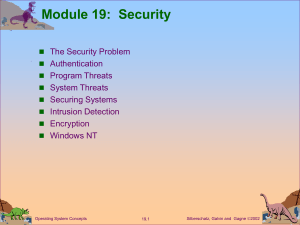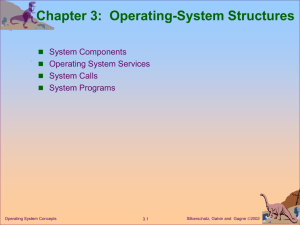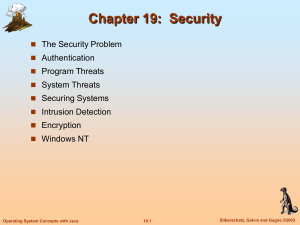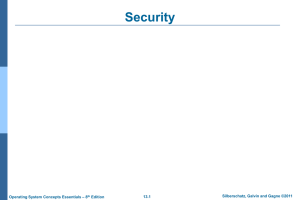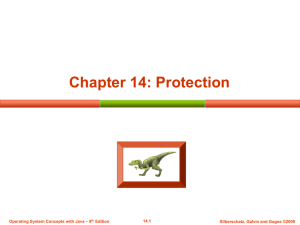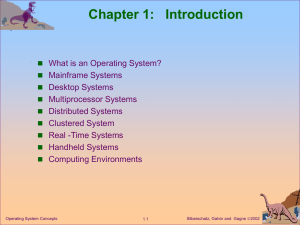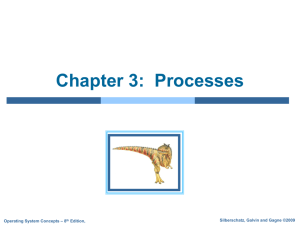IPC
advertisement
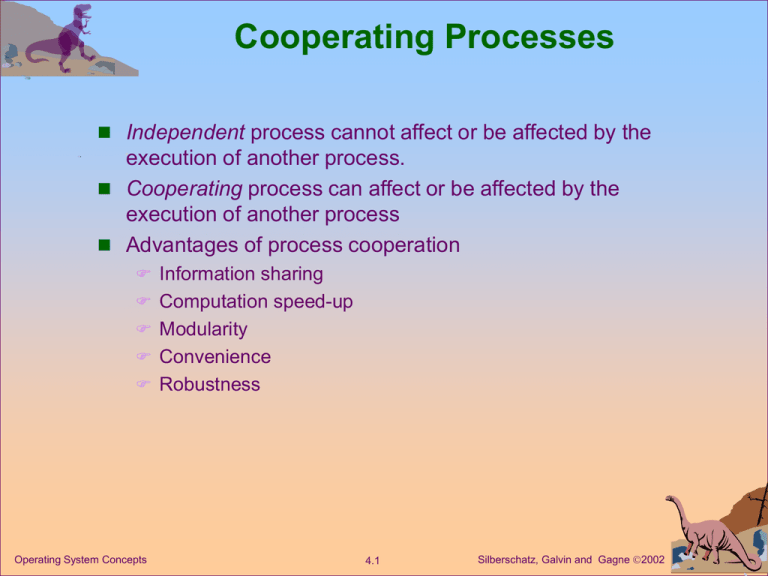
Cooperating Processes
Independent process cannot affect or be affected by the
execution of another process.
Cooperating process can affect or be affected by the
execution of another process
Advantages of process cooperation
Information sharing
Computation speed-up
Modularity
Convenience
Robustness
Operating System Concepts
4.1
Silberschatz, Galvin and Gagne 2002
Producer-Consumer Problem
Paradigm for cooperating processes, producer process
produces information that is consumed by a consumer
process.
unbounded-buffer places no practical limit on the size of the
buffer.
bounded-buffer assumes that there is a fixed buffer size.
Operating System Concepts
4.2
Silberschatz, Galvin and Gagne 2002
Mechanisms for IPC
Operating System Concepts
4.3
Silberschatz, Galvin and Gagne 2002
Bounded-Buffer – Shared Memory Solution
Shared data
#define BUFFER_SIZE 10
typedef struct {
. . .
} item;
item buffer[BUFFER_SIZE];
int in = 0;
int out = 0;
Operating System Concepts
4.4
Silberschatz, Galvin and Gagne 2002
Bounded-Buffer – Shared Memory Solution
Producer
while (1) {
while (((in + 1) % BUFFER_SIZE) == out)
; /* do nothing */
buffer[in] = nextProduced;
in = (in + 1) % BUFFER_SIZE;
}
Consumer
while (1) {
while (in == out)
; /* do nothing */
nextConsumed = buffer[out];
out = (out + 1) % BUFFER_SIZE;
Can only use BUFFER_SIZE-1 elements
Operating System Concepts
4.5
Silberschatz, Galvin and Gagne 2002
Message Passing
Processes communicate without shared variables
If P and Q wish to communicate, they need to:
establish a communication link between them
send(message)
receive(message)
Producer - Consumer
while (1) {
send(consumer,produceNext());
}
while (1) {
nextToConsume = receive(producer);
}
Operating System Concepts
4.6
Silberschatz, Galvin and Gagne 2002
Message Passing - Link Properties
How are links established?
Can a link be associated with more than two processes?
How many links can there be between processes?
What is the capacity of a link? (buffers?)
Fixed or variable size messages?
Is the link simplex or duplex or full duplex?
Operating System Concepts
4.7
Silberschatz, Galvin and Gagne 2002
Message Passing - Logical Properties
Direct or indirect communication (process or mailbox)
Symmetric or asymmetric (names both ways or one way)
Automatic or explicit or no buffering
Send by copy or send by reference
Fixed or variable size messages
Synchronous (blocking) or asynchronous (non-blocking)
Operating System Concepts
4.8
Silberschatz, Galvin and Gagne 2002
Symmetry of naming
Operating System Concepts
4.9
Silberschatz, Galvin and Gagne 2002
Direct Communication
Symmetric: Processes name each explicitly
send (P, message) – send a message to process P
receive(Q, message) – receive a message from process Q
Links are established automatically, on demand.
A link is associated with exactly two processes.
Between each pair there exists exactly one link.
Asymmetric: Only sender names the receiver
send (P, message) – send message to process P
receive(?, message) – receive message from anyone
Asymmetric: Only receiver names the sender
send (?, message) – send message to anyone (copies?)
receive(Q, message) – receive message from process Q
Operating System Concepts
4.10
Silberschatz, Galvin and Gagne 2002
Indirect Communication
Messages are directed and received from mailboxes (also
referred to as ports).
Each mailbox has a unique id.
Processes can communicate only if they share a mailbox.
Operations
Create a new mailbox (Ownership? Who receives?)
send(A,message) – send a message to mailbox A
message = receive(A) – receive a message from A
Destroy a mailbox (? If owner terminates)
Properties of communication link
Link established only if processes share a common mailbox
A link may be associated with many processes.
Each pair of processes may share several links.
Operating System Concepts
4.11
Silberschatz, Galvin and Gagne 2002
Indirect Communication
Mailbox sharing
P1, P2, and P3 share mailbox A.
P1, sends; P2 and P3 receive.
Who gets the message?
Solutions
Allow a link to be associated with at most two processes.
Allow only one process at a time to execute a receive
Allow the system to select arbitrarily the receiver.
Sender is notified who the receiver was.
Atomicity, regardless
Operating System Concepts
4.12
Silberschatz, Galvin and Gagne 2002
Synchronization
Send and receive can be blocking or non-blocking
Blocking send waits until message is received
Non-blocking send allows sender to continue
Sender is not assured of reception - must ack
Sender
send(receiver,message);
receive(receiver,ack_message);
Receiver
receive(sender,message);
send(sender,”ack”);
Blocking receive waits until message is available
Non-blocking receive returns null if no message
Blocking send and receives forces a rendezvous
Operating System Concepts
4.13
Silberschatz, Galvin and Gagne 2002
Buffering
Queue of messages attached to the link; implemented in
one of three ways.
Zero capacity – 0 messages
Sender must wait for receiver (must rendezvous).
o Bounded capacity – finite length of n messages
Sender must wait if link full, or overwrite
o Unbounded capacity – infinite length (right!).
o
Operating System Concepts
4.14
Silberschatz, Galvin and Gagne 2002
Exception Conditions
Process terminates
Receiver waiting for a message from terminated sender
Notify or terminate receiver
Sending to a terminated receiver
Delete message
Notify sender?
Lost messages
Detect with timeouts - expect an ack within some time
Resend (duplicates)
Scrambled messages
Error checking codes
Operating System Concepts
4.15
Silberschatz, Galvin and Gagne 2002


